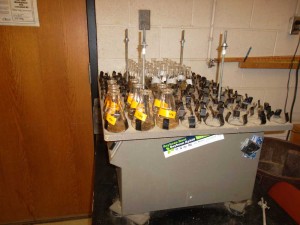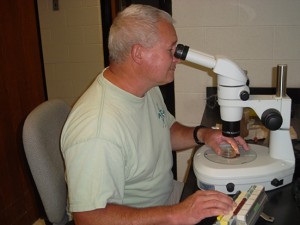
The pellet is re-suspended and the sample spun a second time. With this form of gradient centrifugation, nematodes, most other microscopic animals, fungi, weed seeds, etc., are suspended in the sucrose with only the sand grains forming a pellet. The sucrose solution is then poured over a fine-mesh sieve to catch the nematodes. They are then rinsed into a test tube and are ready to be identified and counted under a dissecting or inverted microscope (fig. 2).
Some nematodes enter plant tissues to feed. Most feed within or on root tissue but there are some species that feed on foliage. To extract nematodes from plant tissues, we use a shaker technique where roots or leaves are washed, weighed and then placed in flasks containing an incubation solution (fig. 3). After approximately 72 hours on the shaker, most of the nematodes have moved out of the plant tissues and into the solution. The solution is then poured over sieves trapping the nematodes. The nematodes are rinsed into test tubes and are once again ready for microscopic observation.
There are other procedures that can be used to assess nematode population densities but centrifugation/flotation and the shaker are by far the ones most commonly utilized at MSU Plant and Pest Diagnostics. The biggest advantage they offer is the speed in which nematode samples can be processed.
07.17.14


 Print
Print Email
Email


